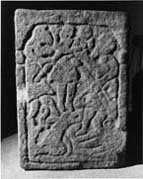Select a site alphabetically from the choices shown in the box below. Alternatively, browse sculptural examples using the Forward/Back buttons.
Chapters for this volume, along with copies of original in-text images, are available here.
Object type: Cross-base [1]
Measurements: H. 68.5 cm (27 in); W. 47 cm (18.5 in); D. 39.4 cm (15.5 in) Socket: 33 x 24.2 x 7.6 cm (13 x 9.5 x 3 in)
Stone type: Coarse-/very coarse-grained, massive yellow sandstone
Plate numbers in printed volume: Pls. 26. 139-142, 27.143
Corpus volume reference: Vol 1 p. 58
(There may be more views or larger images available for this item. Click on the thumbnail image to view.)
The top is only shallowly recessed by c. 3 in; obviously the shaft was held by a dowel-hole, 2 in diameter, which is centrally placed in the depression.
A (broad): Very worn. Surrounded by a flat-band moulding supported at the sides by what appear to be columns and capitals, a figure group is standing over a bound animal. The figures are lightly grooved. In the centre are what may be two forward-looking heads, although only the one on the left seems to be attached to a body. Its right arm is upraised and it stands with feet pointed forward and slightly turned. It appears to have a short kirtle and slippers. On the left a bearded figure is shown in profile in the act of thrusting a staff into the face of the central figure. On the right a similar figure is similarly bearded and dressed in a short kirtle. He too holds a pole which seems to terminate round about the waist of the central figure with a rounded feature. This could be his right hand; if so, it appears that the pole has entered the body of the central figure. Fitted in between the feet of these figures is a canine-type animal. It has a long muzzle with a single fang, a long oval eye and a slightly rounded ear. The ear seems to join a strand which passes behind the animal's neck and forms a twist between the feet of the left-hand figure (see Lindisfarne 8). It appears as though one leg and paw are raised under the feet of the left-hand figure and the other over the feet of the right-hand figure. The beast's body seems to melt into a fan-like feature.
B (narrow): A panel of bungled interlace is surrounded by a flat-band moulding of uneven width. At the top is a ring-knot with an elaborate dependent terminal (see Lindisfarne 3 and 5 and Durham 2).
C (broad): A panel of confused interlace is surrounded by a flat-band moulding of irregular width. The upper motif is formed by a pair of Stafford Knots joined horizontally and vertically with angular strands. From it depends a free ring attached to a double triangular feature and it is surrounded by spirals (see Lindisfarne 38).
D (narrow): Nearly all the ornament has been chiselled away save a shadow of an interlace pattern in the top right-hand corner.
The interpretation of the figure scene is not easy. Browne (1883, 185-7) says that it is the seed of Eve bruising the serpent's head and compares Dearham and Kirkdale. It is possible, however, that it is a garbled Crucifixion scene, in which the central frontal figure is flanked by the lance-bearer and sponge-bearer, and the devil in the form possibly of the wolf Fenrir lies bound at Christ's feet. Alternatively, it might be a scene of the Massacre of the Innocents. It is difficult to be certain of the iconography in a technique where each figure fits jig-saw fashion against the next, thus leaving very little room for manoeuvre. If we are to see the whole scene as integrated, then possibly the Crucifixion is the best interpretation. The `loose head' on the right of the central figure could then be the sun or moon. This socket is closely linked in style with Lindisfarne in the form of the animal and the type of ring-knot (Introduction, p. 18). Chester-le-Street 7 has similar spiraliform interlace. The loose terminals for the interlace and the free ring fit best in an Anglo-Scandinavian context, while the type of figural composition can be compared with Tynemouth 2 and Ovingham 1.



